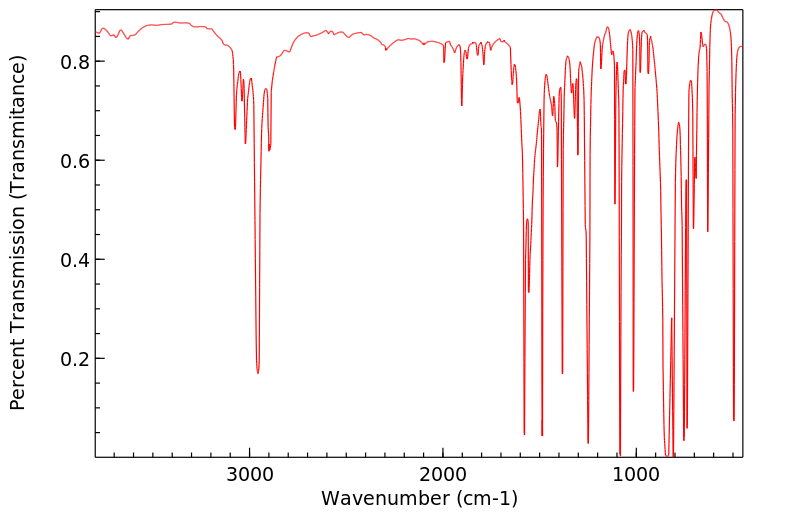1-氯-4-(三甲基甲硅烷基)苯 | 10557-71-8
中文名称
1-氯-4-(三甲基甲硅烷基)苯
中文别名
对氯苯基三甲基硅烷
英文名称
4-chlorophenyltrimethylsilane
英文别名
1-chloro-4-(trimethylsilyl)benzene;p-chlorotrimethylsilyl benzene;p-Chlorophenyltrimethylsilane;(4-chlorophenyl)-trimethylsilane
CAS
10557-71-8
化学式
C9H13ClSi
mdl
——
分子量
184.741
InChiKey
LCQUSGXMZKOTPG-UHFFFAOYSA-N
BEILSTEIN
——
EINECS
——
-
物化性质
-
计算性质
-
ADMET
-
安全信息
-
SDS
-
制备方法与用途
-
上下游信息
-
文献信息
-
表征谱图
-
同类化合物
-
相关功能分类
-
相关结构分类
物化性质
-
熔点:°C
-
沸点:98-100 °C20 mm Hg(lit.)
-
密度:0.995 g/mL at 25 °C(lit.)
-
闪点:171 °F
-
稳定性/保质期:
避免光、明火和高温,以及强氧化剂。
计算性质
-
辛醇/水分配系数(LogP):2.89
-
重原子数:11
-
可旋转键数:1
-
环数:1.0
-
sp3杂化的碳原子比例:0.33
-
拓扑面积:0
-
氢给体数:0
-
氢受体数:0
安全信息
-
TSCA:Yes
-
安全说明:S16,S26,S36/37/39
-
危险类别码:R36/38,R11
-
WGK Germany:3
-
危险品运输编号:UN 1993
-
海关编码:2931900090
-
储存条件:请将药品存放在密闭、阴凉干燥的地方。
SDS
上下游信息
-
下游产品
中文名称 英文名称 CAS号 化学式 分子量 三甲基苯基硅烷 trimethylphenylsilane 768-32-1 C9H14Si 150.296 1,4-二(三甲基硅烷基)苯 1,4-bis-(trimethylsilyl)benzene 13183-70-5 C12H22Si2 222.478 4-(三甲基甲硅烷基)苯胺 4-(trimethylsilyl)aniline 17889-23-5 C9H15NSi 165.31
反应信息
-
作为反应物:描述:参考文献:名称:可见光光催化芳基硅烷原去甲硅烷基化摘要:提出了第一个可见光介导的光催化、无金属和无碱的芳基硅烷原型脱硅烷化。C(sp 2 )-Si 键断裂过程由 5 mol% 负载的市售吖啶盐在蓝光照射下催化。已经确定了两种使用需氧或氢原子转移助催化条件的简单方法,它们能够在温和条件下对多种简单和复杂的芳基硅烷进行有效和选择性的去甲硅烷基化。DOI:10.1021/acs.orglett.2c00288
-
作为产物:描述:氯苯基三氯硅烷 以 not given 为溶剂, 以90%的产率得到1-氯-4-(三甲基甲硅烷基)苯参考文献:名称:Chvalovsky, V.; Bazant, V., Collection of Czechoslovak Chemical Communications, 1951, vol. 16, p. 580 - 590摘要:DOI:
文献信息
-
Pd-Catalyzed α-Arylation of α,α-Difluoroketones with Aryl Bromides and Chlorides. A Route to Difluoromethylarenes作者:Shaozhong Ge、Wojciech Chaładaj、John F. HartwigDOI:10.1021/ja501117v日期:2014.3.19α-difluoroketones with aryl and heteroaryl bromides and chlorides catalyzed by an air- and moisture-stable palladacyclic complex containing P(t-Bu)Cy2 as ligand. The combination of this Pd-catalyzed arylation and base-induced cleavage of the acyl–aryl C–C bond within the α-aryl-α,α-difluoroketone constitutes a one-pot, two-step procedure to synthesize difluoromethylarenes from aryl halides. A broad range
-
CuI/Oxalamide Catalyzed Couplings of (Hetero)aryl Chlorides and Phenols for Diaryl Ether Formation作者:Mengyang Fan、Wei Zhou、Yongwen Jiang、Dawei MaDOI:10.1002/anie.201601035日期:2016.5.17Couplings between (hetero)aryl chlorides and phenols can be effectively promoted by CuI in combination with an N‐aryl‐N′‐alkyl‐substituted oxalamide ligand to proceed smoothly at 120 °C. For this process, N‐aryl‐N′‐alkyl‐substituted oxalamides are more effective ligands than bis(N‐aryl)‐substituted oxalamides. A wide range of electron‐rich and electron‐poor aryl and heteroaryl chlorides gave the corresponding
-
Coupling of Reformatsky Reagents with Aryl Chlorides Enabled by Ylide‐Functionalized Phosphine Ligands作者:Zhiyong Hu、Xiao‐Jing Wei、Jens Handelmann、Ann‐Katrin Seitz、Ilja Rodstein、Viktoria H. Gessner、Lukas J. GooßenDOI:10.1002/anie.202016048日期:2021.3.15organozinc reagents with aryl electrophiles using a cyclohexyl‐YPhos ligand bearing an ortho‐tolyl‐substituent in the backbone. This highly electron‐rich, bulky ligand enables the use of aryl chlorides in room temperature couplings of Reformatsky reagents. The reaction scope covers diversely functionalized arylacetic and arylpropionic acid derivatives. Aryl bromides and chlorides can be converted selectively
-
아릴 아민기를 포함하는 비대칭 피렌 유도체 및 이를 포함하는 유기 발광 소자申请人:SFC CO., LTD. 에스에프씨 주식회사(120060087061) Corp. No ▼ 135511-0105889BRN ▼134-81-54429公开号:KR102156562B1公开(公告)日:2020-09-16본 발명은 하기 [화학식 A] 또는 [화학식 B]로 표시되는 비대칭 피렌 유도체 및 이를 포함하는 유기 발광 소자에 관한 것으로, 치환기 Ar1, Ar2, Ar3, Ar4, Z 및 m는 발명의 상세한 설명에 정의된 바와 동일하다. [화학식 A] [화학식 B]
-
Sterically Controlled Iodination of Arenes via Iridium-Catalyzed C–H Borylation作者:Benjamin M. Partridge、John F. HartwigDOI:10.1021/ol303164h日期:2013.1.4to prepare aryl and heteroaryl iodides by sequential C–H borylation and iodination is reported. The regioselectivity of this process is controlled by steric effects on the C–H borylation step and is complementary to existing methods to form aryl iodides. The iodination of boronic esters has potential for the synthesis of radiolabeled aryl iodides, as demonstrated by the concise synthesis of a potential
表征谱图
-
氢谱1HNMR
-
质谱MS
-
碳谱13CNMR
-
红外IR
-
拉曼Raman
-
峰位数据
-
峰位匹配
-
表征信息
同类化合物
(βS)-β-氨基-4-(4-羟基苯氧基)-3,5-二碘苯甲丙醇
(S,S)-邻甲苯基-DIPAMP
(S)-(-)-7'-〔4(S)-(苄基)恶唑-2-基]-7-二(3,5-二-叔丁基苯基)膦基-2,2',3,3'-四氢-1,1-螺二氢茚
(S)-盐酸沙丁胺醇
(S)-3-(叔丁基)-4-(2,6-二甲氧基苯基)-2,3-二氢苯并[d][1,3]氧磷杂环戊二烯
(S)-2,2'-双[双(3,5-三氟甲基苯基)膦基]-4,4',6,6'-四甲氧基联苯
(S)-1-[3,5-双(三氟甲基)苯基]-3-[1-(二甲基氨基)-3-甲基丁烷-2-基]硫脲
(R)富马酸托特罗定
(R)-(-)-盐酸尼古地平
(R)-(-)-4,12-双(二苯基膦基)[2.2]对环芳烷(1,5环辛二烯)铑(I)四氟硼酸盐
(R)-(+)-7-双(3,5-二叔丁基苯基)膦基7''-[((6-甲基吡啶-2-基甲基)氨基]-2,2'',3,3''-四氢-1,1''-螺双茚满
(R)-(+)-7-双(3,5-二叔丁基苯基)膦基7''-[(4-叔丁基吡啶-2-基甲基)氨基]-2,2'',3,3''-四氢-1,1''-螺双茚满
(R)-(+)-7-双(3,5-二叔丁基苯基)膦基7''-[(3-甲基吡啶-2-基甲基)氨基]-2,2'',3,3''-四氢-1,1''-螺双茚满
(R)-(+)-4,7-双(3,5-二-叔丁基苯基)膦基-7“-[(吡啶-2-基甲基)氨基]-2,2”,3,3'-四氢1,1'-螺二茚满
(R)-3-(叔丁基)-4-(2,6-二苯氧基苯基)-2,3-二氢苯并[d][1,3]氧杂磷杂环戊烯
(R)-2-[((二苯基膦基)甲基]吡咯烷
(R)-1-[3,5-双(三氟甲基)苯基]-3-[1-(二甲基氨基)-3-甲基丁烷-2-基]硫脲
(N-(4-甲氧基苯基)-N-甲基-3-(1-哌啶基)丙-2-烯酰胺)
(5-溴-2-羟基苯基)-4-氯苯甲酮
(5-溴-2-氯苯基)(4-羟基苯基)甲酮
(5-氧代-3-苯基-2,5-二氢-1,2,3,4-oxatriazol-3-鎓)
(4S,5R)-4-甲基-5-苯基-1,2,3-氧代噻唑烷-2,2-二氧化物-3-羧酸叔丁酯
(4S,4''S)-2,2''-亚环戊基双[4,5-二氢-4-(苯甲基)恶唑]
(4-溴苯基)-[2-氟-4-[6-[甲基(丙-2-烯基)氨基]己氧基]苯基]甲酮
(4-丁氧基苯甲基)三苯基溴化磷
(3aR,8aR)-(-)-4,4,8,8-四(3,5-二甲基苯基)四氢-2,2-二甲基-6-苯基-1,3-二氧戊环[4,5-e]二恶唑磷
(3aR,6aS)-5-氧代六氢环戊基[c]吡咯-2(1H)-羧酸酯
(2Z)-3-[[(4-氯苯基)氨基]-2-氰基丙烯酸乙酯
(2S,3S,5S)-5-(叔丁氧基甲酰氨基)-2-(N-5-噻唑基-甲氧羰基)氨基-1,6-二苯基-3-羟基己烷
(2S,2''S,3S,3''S)-3,3''-二叔丁基-4,4''-双(2,6-二甲氧基苯基)-2,2'',3,3''-四氢-2,2''-联苯并[d][1,3]氧杂磷杂戊环
(2S)-(-)-2-{[[[[3,5-双(氟代甲基)苯基]氨基]硫代甲基]氨基}-N-(二苯基甲基)-N,3,3-三甲基丁酰胺
(2S)-2-[[[[[((1S,2S)-2-氨基环己基]氨基]硫代甲基]氨基]-N-(二苯甲基)-N,3,3-三甲基丁酰胺
(2S)-2-[[[[[[((1R,2R)-2-氨基环己基]氨基]硫代甲基]氨基]-N-(二苯甲基)-N,3,3-三甲基丁酰胺
(2-硝基苯基)磷酸三酰胺
(2,6-二氯苯基)乙酰氯
(2,3-二甲氧基-5-甲基苯基)硼酸
(1S,2S,3S,5S)-5-叠氮基-3-(苯基甲氧基)-2-[(苯基甲氧基)甲基]环戊醇
(1S,2S,3R,5R)-2-(苄氧基)甲基-6-氧杂双环[3.1.0]己-3-醇
(1-(4-氟苯基)环丙基)甲胺盐酸盐
(1-(3-溴苯基)环丁基)甲胺盐酸盐
(1-(2-氯苯基)环丁基)甲胺盐酸盐
(1-(2-氟苯基)环丙基)甲胺盐酸盐
(1-(2,6-二氟苯基)环丙基)甲胺盐酸盐
(-)-去甲基西布曲明
龙蒿油
龙胆酸钠
龙胆酸叔丁酯
龙胆酸
龙胆紫-d6
龙胆紫







